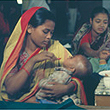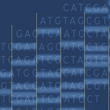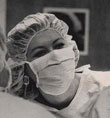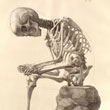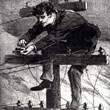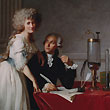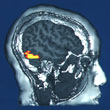The Exhibition Program creates both physical and virtual exhibitions. Take a behind the scenes look at making exhibitions happen.
News of the Past
Changing the Face of Medicine: Celebrating America’s Women Physicians
In 2000 the National Library of Medicine began developing an exhibition about the history of America’s women physicians. The Exhibition Program was challenged to include 340 doctors spanning 160 years, with the goals of illustrating the larger themes in the history of women in medicine, while inspiring the next generation of physicians.
Changing the Face of Medicine: Celebrating America’s Women Physicians opened in October 2003. By integrating personal stories of struggle and success with poignant artifacts and photographs, visitors get to read, hear, and see for themselves the incredible stories of the featured physicians.
The Exhibition Program developed several strategies to provide on-site and on line visitors access to this unprecedented presentation of information about the history of women physicians.
Read about the components that create Changing the Face of Medicine.
The focus of Changing the Face of Medicine is the incredible stories of each physician included in the exhibition. There are personal stories of resolve and determination, obstacles and triumphs. Their biographies illustrate the complex relationship between family, society, self, and career.
During the research phase of Changing the Face of Medicine, these stories were collected through a combination of historical research and interviews. As this process continued, it became evident that the breadth and depth of the biographies might overwhelm visitors.
Early in the development process, the team examined the information collected and looked for consistency among the biographies. What emerged was a list of types of information that could be presented on each of the doctors. These key facts included location and type of practice, medical school, career paths and achievements.
The challenge for the Exhibition Program was to present this information in an organized way for our visitors to review. The result is the Digital Portrait Gallery. By entering all of the biographies into an electronic database, the information became searchable and sortable. This functionality allowed the team to give the visitor the ability to choose content based on their own interests, leaning style, and time commitment.
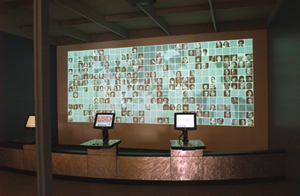
Digital Portrait Gallery
By combining a large presentation screen with three interactive kiosks, the Digital Portrait Gallery presents this information in a dynamic, constantly changing way. Visitors make selections based on five search categories. They can search for physicians in their home state, by different medical schools, by the physicians professional achievements, and by different career paths. The results of their searches are then displayed on the large screen in front of them, while the biographies of those doctors appear on the individual kiosks. The design is straightforward, graphically intuitive, and provides the user with an immediate and interactive payoff.
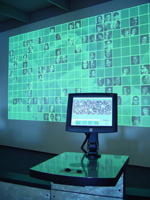
Kiosk where visitors make selections
The large projection screen showcases the faces of each of the doctors included in the exhibition. Here visitors get a chance to see the incredible diversity included in the show. At a glance one can see women of different ages and backgrounds from the past 150 years.
When visitors do make their selections, the screen reacts This interplay of visitor with the kiosk and wall provides the visitor with a visually interesting wealth of information. There is little time needed to learn how to use the database and more time can be used exploring the information.
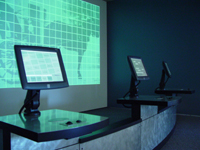
Three kiosks allow for several users to interact
For our visitors, exploring 330 biographies could be an overwhelming experience. By creating an experience that reacts to audience input, visitors are more likely to explore the content, and to have a meaningful connection with the physicians.
Online visitors can also search the database to discover more about different physicians: http://www.nlm.nih.gov/changingthefaceofmedicine/physicians/
Visitors attending Changing the Face of Medicine come to the Library with a variety of goals. Many want to learn about specific women physicians, while others want a broader understanding of the history of women in medicine. Some visitors have a long amount of time to spend in the gallery, while others do not. Many viewers prefer media-rich experiences to simply reading text on the wall.
The videos allow us to provide different layers of information and styles of presentation to visitors in a series of short films. Each has several film clips of different physicians. A combination dial and button allow users to choose which story they want to see. The experience is exploratory and self directed.
Each provides a wealth of knowledge. The movies are a combination of evocative imagery. They include intimate photographs and video of the physicians, allowing the visitor to get a complete look at the relationship between their work and the world around them. Video interviews allow the physicians to speak for themselves, giving first hand accounts of their experiences.
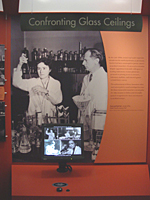
Many women included in the exhibition were born in the mid-1800s. While learning about these women is essential for understanding the larger historical narrative of women in medicine, some did not leave behind a rich material culture. Audiovisuals allowed the Exhibition Program to bring these stories to life by using a narrated voiceover while showing period photographs and historical documents.
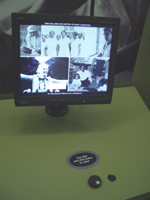
The kiosks also allow important stories of current women physicians who might not have related artifacts to be told in the context of the exhibition. This media often allowed the subject of the exhibition to speak for themselves about important topics in their lives and careers.
Online visitors can view these multimedia presentations. Explore the Exhibition, and look for physicians who have a video link next to their name.
Changing the Face of Medicine features five artifact interactives that make the artifacts come alive. Located next to the actual artifact in the exhibition galleries, these interactives allow visitors to learn more about the individual objects and their significance. They give life to the artifacts, showing them in motion, allowing visitors to zoom closer to see details, and see all sides of an artifact.
Presenting an artifact in a case always presents limitations. Often the space is limited, the artifact must compete with labels images, as well as other artifacts. The content within the cases is devoted to specific physicians. Artifacts cannot move or be manipulated, often only one side is viewable. The artifact interactives are an exciting way to solve all of these challenges. They allow visitors to choose to learn more about the specific item they are seeing. Here we can discuss facts not specifically related to the biography presented, and provide an opportunity to explore the work or interests of the physician.
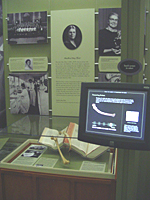
Visitors can drag a slider at the bottom of the screen to view the artifact from all sides. Visitors can simulate looking through a microscope and zooming to different magnifications, as well as view the damage done to bones by disease.
The interactives use Flash animations, photography, and 360 degree photography on 15 inch touch screen monitors in order to give visitors the ability to manipulate the content however they like. The animations give life and offer meaning to artifacts that are otherwise still within the case.
These interactives are available online. Explore the Exhibition, and look for physicians who have an Artifact Interactive link next to their name, such as Mary Putnam Jacobi.
Changing the Face of Medicine: Celebrating America’s Women Physicians celebrates the past, while keeping an eye on the future. It presents the stories of physicians from the past 150 years in dynamic, easy to access biographies that combine various media. It provides for educational learning experiences while giving visitors helpful information they can use to create their own path in medicine.
Each of the over 330 biographies presented on the web site provides examples of the struggles women have faced to attain various roles in the medical field. The biographical approach appeals to a broad audience and is especially useful in helping our visitors to understand and empathize with historical subjects. It is the lives of these physicians that form the core of the web site.
Each physician in the exhibition has her own biographical page with factual data, and a narrative write-up of her life and role in medicine. A photo gallery and links to media are also provided. The visitor gains further insight to the physician’s personal motivations and experiences by reading physician responses to questions about inspiration, mentors, and obstacles.
The web page provides several dynamic avenues for getting at these biographical pages. In Explore the Exhibition the biographies are woven together by a historical narrative. This narrative provides a thematically based approach which addresses the major issues that affected early generations of women physicians as well as current topics still affecting women in medicine. As visitors read the narrative they meet key women who exemplify each theme. A brief overview of the doctor is given, along with links to their complete biography. Many of these physicians have video treatments and artifact based interactive to further illustrate their stories.
Visitors to the site can also gain access to the doctors’ stories by going to the Physicians section. Here there are a variety of search options, each allowing the visitor to search on their own interests. The results present a set of physicians reflecting the visitor’s interests.
For young students, and the young at heart, the Activities section provides visual and interpretive ways to learn about specific medical and science topics. The visitor is given a chance to test what they’ve learned by playing a game. Each activity features a physician whose work is related to the activity—another way to bring the stories of careers in medicine to life.
Throughout the web site, visitors learn how women physicians have made a difference in the communities they serve, the medical field as a whole, and in the daily lives of their patients. Share Your Story provides visitors with a chance to add their own stories of other women physicians.
The site also has content aimed at inspiring the next generation of physicians. In the Resources section, students of various age levels can find resources to explore diverse medical careers or to develop existing careers. Teachers can find lesson plans combining science concepts, health information, and careers in medicine. Further reading provides more resources for those looking to learn even more about the women physicians presented in the exhibition.
Further Exhibition Resources
American Association of Museums
National Association of Museum Exhibitors
Contact Information





